San Francisco's Cable Cars
San Francisco - the city whose steep hills inspired the concept of cable cars, and the only place that still has 'em.
- Cable Car Lines/Routes Powell-Hyde Line Powell-Mason Line California Line Stations/Turnaround Points Powell Street & Market Street Hyde Street & Beach Street Taylor Street & Bay Street California Street & Drumm Street California Street & Van Ness Avenue Cable Car Facts The Cable Car Museum Fares & Riding Tips Cable Car History
Powell-Hyde Line
- Back to Top
- The Powell-Hyde line starts at Powell & Market and ends at Hyde & Beach Streets, at Maritime Park. The Hyde Street Pier (with historic sailing vessels), Jefferson Street/Fishermen's Wharf (west end), and Ghiradelli Square are nearby.
- This line runs past the top of Lombard Street, before its final steep hill descent. Lombard Street is four blocks up the hill from the end point. If you board a northbound car at Lombard, it'll be a short trip.
- This is arguably the most scenic of all three lines, traveling past the shops and restaurants of Russian Hill, offering quick sweeping east views at Greenwich and Lombard, and then descending toward the bay on the last steep hill.
- If you're travling this line from Hyde & Beach back to Union Square at evening or nighttime, try to board the car at the very back. You'll get the best views.
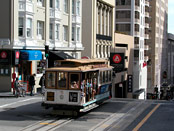
Powell-Hyde Car 5 passes Academy of Art University - so this could be anywhere in SF
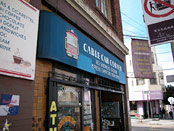
Little groceries and cafes on Powell have named themselves after the cable cars
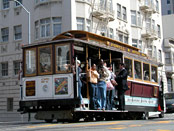
Powell-Hyde Car crosses Washington Street before taking its first turn onto Jackson
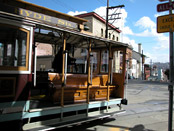
An empty Car rounding the corner from Washington on to Powell Street
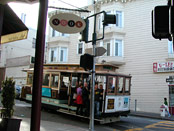
Turning on to Hyde Street from Jackson, at Nook Cafe in Russian Hill
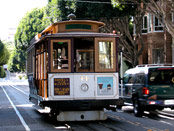
Most of the Hyde Street segment of the route is lined with trees
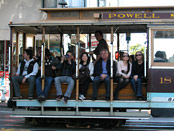
If you can manage to get an outside seat on a car with no standing riders, you'll be set up for great photos
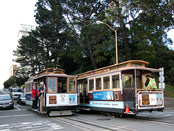
Two cars crossing on Hyde Street at Lombard
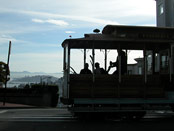
Car passing the top of Lombard Street on Hyde Street
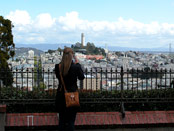
The Powell-Hyde line passes by the top of Lombard Street - a celebrity in the world of tourist spots
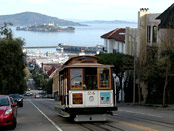
Climbing Hyde Street to Chestnut, Alcatraz in the background
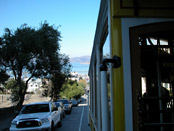
The bay comes into the view looking back from a Car climbing Hyde Street
Powell-Mason Line
- Back to Top
- The Powell-Mason line starts at Powell & Market and ends at Taylor & Bay Streets, two blocks short of the middle section of Jefferson Street/Fishermen's Wharf. Pier 39 is four blocks to the northeast.
- This is the oldest cable car line (and reportedly the oldest unchanged transit line in the world), and follows the same route as when it opened in 1888.
- This line is the only one of the three that directly intersects North Beach, hitting Columbus Avenue between Greenwich and Chestnut.
- It also stops along Mason Street two blocks west of Chinatown. The operator will call out the Chinatown stop, but if you exit there from a northbound car, you'll miss most of the ride.
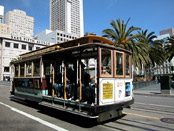
Powell-Mason and Powell-Hyde Cars both inch past Union Square
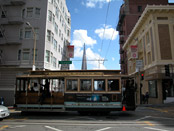
Cable car 18 crossing Clay Street, giving riders a quick glimpse of the Transamerica Tower
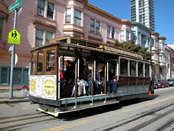
Powell-Mason Car about to cross Broadway
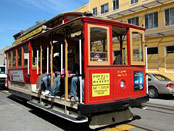
Red Car 25 on Mason at Jackson Street
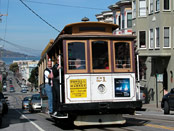
A familiar photo vantage point - Mason Street at Filbert, with the bay in the background
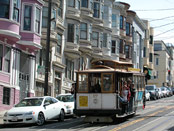
One of the few spots where the cable car passes a distinctive row of Victorians, on Mason between Union and Filbert
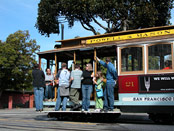
Powell-Mason Car 21 intersects Columbus Avenue in North Beach
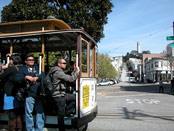
The Powell-Mason line crosses through North Beach - Coit Tower is in the background
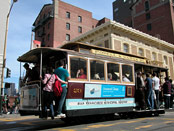
Hanging on to the side of the back section is allowed, as well as the front
California Street Line
- Back to Top
- The California Street line starts at California Street & Drumm Street and ends at California Street & Van Ness Avenue.
- Unfortunately for tourists, the endpoint at California Street & Van Ness Avenue tends to be an anticlimactic destination.
- This cable car line is the only one of the three which follows a straight line (east-west along California Street) and has no turns.
- The California Street cable cars are bi-directional, having a grip mechanism at each end. This means they do not have to be rotated at the end-points. It also makes them longer than cars on the Powell lines.
- This line is actually used by commuting locals far more often than the Powell lines.
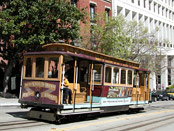
California Street Car near Grant Avenue
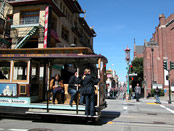
The California Street line crosses through Chinatown
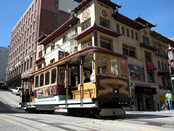
California Street Car stopped at Grant Avenue
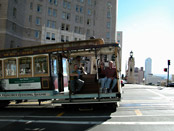
California Street cable car in front of the Mark Hopkins Hotel at the top of Nob Hill
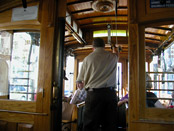
Inside the cable car on the California Street line
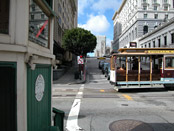
Cable car 2 crossing California Street on Powell Street at the signal booth
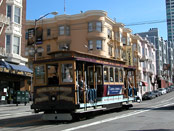
California Street car at Hyde Street, after descending Nob Hill
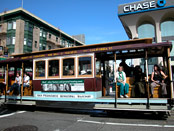
Cars on the California Street line are longer than those on the Powell lines
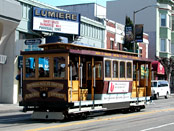
In front of the Lumiere Theater on California Street just before Polk Street
Powell Street & Market Street
- Back to Top
- South turnaround point for both the Powell-Hyde and Powell-Mason lines. Check the sign at the top of the cable car to see which stop it is bound for (Hyde signs are reddish-brown, Mason signs are yellow).
- The longest lines to board the cable cars are here, partly because it is serving two lines from a single turnaround point.
- Cars wait in a queue along Powell Street until it is their turn to move up to the boarding point.
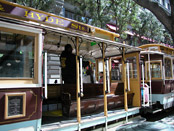
Cable cars at rest on Powell Street, in the queue for the turnaround
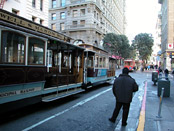
Empty cable cars stack up on Powell Street waiting for the turnaround and boarding point
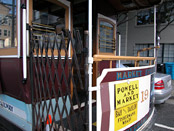
Rear of cable car 19, at rest on Powell Street
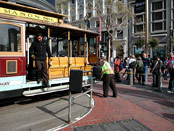
Cars are rotated on the turntable at Powell Street
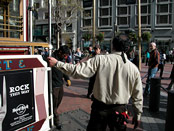
Bystanders are no longer allowed to help turn the Cars
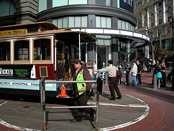
Once the Car is lined up, it is pushed out from the turntable onto the track
Hyde Street & Beach Street
- Back to Top
- North turnaround point for the Powell-Hyde line, at Maritime Park. The section where the cars are turned is also known as Victorian Park. It is close to the Hyde Street Pier, Aquatic Park (the small shoreline to the Bay), Ghiradelli Square, The Cannery, Fishermen's Wharf, and Fort Mason.
- This turnaround point was dedicated in 1997 to activist Friedel Klussmann. During 1947-1952 she fought against the mayor's plan to shut down the remaining cable car systems, and gathered enough public support to guarantee their preservation in the city charter.
- If you wait in line to board at this location, you'll likely be the audience for a lone guitarist who has marked this as his spot. He plays "Space Oddity" a lot.
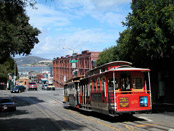
Cable cars on Hyde Street waiting to move to the turnaround point
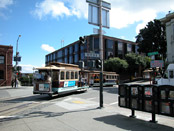
Cable cars arriving and departing on Hyde Street at Beach Street
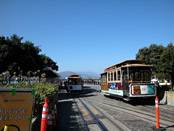
Cable car turnaround at the end of the Powell-Hyde line, at Maritime Park
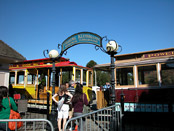
Hyde Street cable car turnaround at Maritime Park
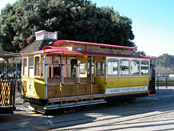
Cable car 15 at the Hyde Street turnaround
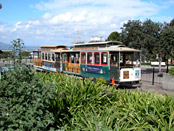
The Hyde Street turnaround, and masts of the ship Balclutha in the background
Taylor Street & Bay Street
- Back to Top
- North turnaround point for the Powell-Mason line. It is two blocks south of the middle section of Fishermen's Wharf, and a block past the foot of North Beach.
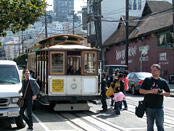
Powell-Mason Cars stop at Taylor and Francisco and riders disembark
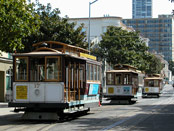
Cars line up on Taylor Street between Francisco and Bay waiting to return to service
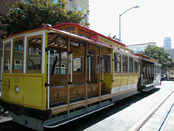
Cable car 15 and others in line for the turnaround at Taylor and Bay Streets
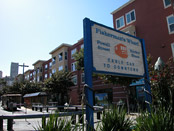
The Powell-Mason line terminal point is two blocks south of Jefferson Street and Fisherman's Wharf
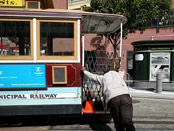
Cars are turned around at Taylor and Bay Streets to return in the opposite direction
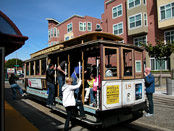
Once they're turned and pushed back on the track, riders can get on from either side
California Street & Drumm Street
- Back to Top
- East turnaround point for the California Street line. It is two blocks west of the Ferry Plaza and Embarcadero.
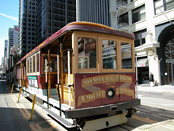
Cable cars stop before Drumm Street and wait to move to the reversal point
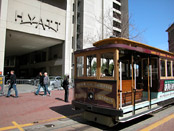
The boarding point is directly across from the Hyatt Regency Hotel at the Embarcadero
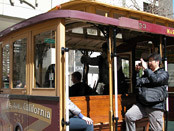
Riders take photos of each other while waiting for the cable car to start up California Street
California Street & Van Ness Avenue
- Back to Top
- This western turnaround point for the California Street line is famous for disappointing tourists. Traffic-heavy Van Ness Avenue has auto dealers, furniture showrooms, and a few restaurants. There is a Whole Foods Market a block further up California Street at Franklin.
- You can dry your tears of disappointment by backtracking one block to Polk Street, which is more amenible to foot traffic and features densely clustered restaurants and shops.
- Following Polk Street north, you'll eventually hit the waterfront just west of where the Powell-Hyde cable car line ends. The distance is about 17 blocks, and it takes about 45 minutes to walk straight through. The 19 bus also travels north-south along Polk.
- From this location, you can also take the 1 bus on Sacramento Street (one block north of California Street) to Fillmore Street. Or you can walk - it's 7 blocks west from Van Ness.
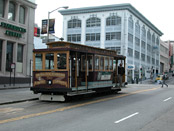
Cable cars on the California line travel directly along California Street without any turns
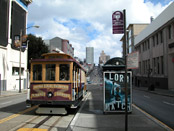
The west terminal point for the California Street line is Van Ness Avenue
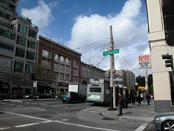
This is Van Ness Avenue at California Street - what you see is what there is
Cable Car Facts
- Back to Top
- Cable cars are "driven" by gripping cables that are constantly moving through two-foot deep tunnels under the street
- Powell Street and California Street is the only point where two different lines cross paths. The small signal booth at the intersection signals right-of-way for approaching cars.
- Operators on the Powell lines must "drop" or let go of the cable at California Street, otherwise the crossing cables would be pulled into contact with each other.
- The newest cable car in the fleet is the distinctive yellow car 15, which was put into service in June 2009. It was built from scratch using 100-year-old blueprints, and cost $823,000.
- Riders and bystanders used to help turn the cable cars around on the turntables. The public is no longer allowed to assist with car turning.
- In 1964, a cable car ride cost 15 cents.
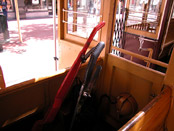
Movement of the cable car is controlled with the grip levers
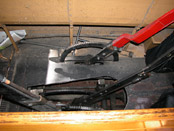
Pulling back on the lever engages a mechanism that grips the moving cable under the street
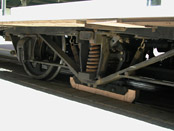
The undercarriage is similar to a train car, the wheels stay on the tracks
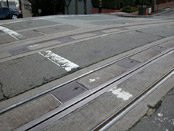
Cable car tracks guide the wheels while the grip mechanism reaches through the slot in the middle where the cable runs
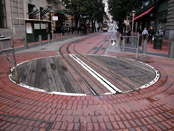
Turntable at Powell and Market, on which cable cars are manually turned around to point the opposite direction
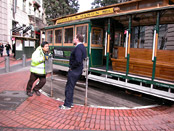
Cable car operators push the turntable around the reverse direction
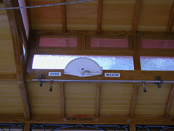
The Powell-Hyde and Powell-Mason lines use the same type of single-direction cars
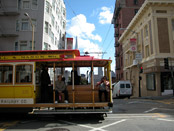
Running on both Powell Street lines, the new cable car 15 is easy to recognize - it's the only yellow car in the fleet
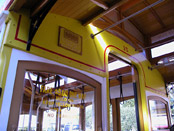
Work on cable car 15 extended over a 5-year period ending in 2009
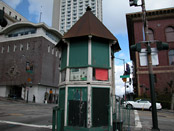
Signal Booth at California and Powell, signalling right of way to crossing cable car lines
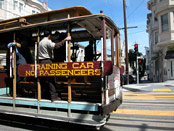
New operators are trained on cars without passengers
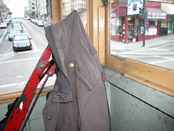
Operators often hang jackets on grip levers while cable cars are at rest
The Cable Car Museum
- Back to Top
- This building at Washington & Mason Streets is both a museum open to visitors and a functioning cable car "garage", powering movement of the underground cables and providing a repair and renovation space for the cars.
- The museum is admission-free and open 10am - 6pm (April - September), and 10am - 5pm (October - March) every day except Christmas, New Year's Day, Easter, & Thanksgiving. 415-474-1887.
- The facility was re-opened in June 1984 following an $18 million dollar complete re-build, concurrent with the renovation of the entire system.
- It was first renovated and opened to the public in 1967, and established as a museum in 1974.
- Use of this site as a car barn and powerhouse dates back to the 1880s, and the current structure is similar in appearance to the original one.
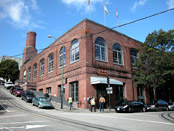
The Cable Car Museum and powerhouse at Washington and Mason Streets
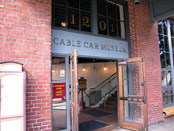
Entrance to the Cable Car Museum
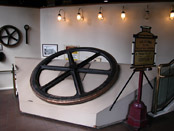
This antique cable wheel is just inside the museum entrance
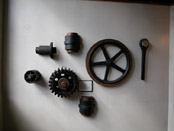
Components of the original systems are displayed and explained in the museum
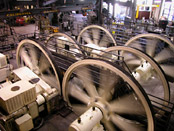
The wheels move the cables through the tunnels under the streets
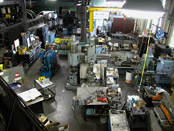
Repair area inside the Cable Car museum
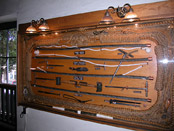
Museum display showing the composition of the cables
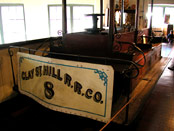
The oldest cable car in the world, this was part of the original Clay Street line in 1873 - the cable is gripped by a screw mechanism
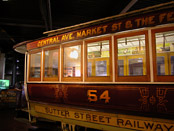
Sutter Street Cable Train number 54 dates back to the 1880s
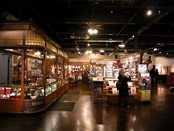
Gift shop inside the Cable Car Museum
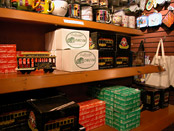
Cable car related souvenirs include shirts, mugs, tote bags, and magnets
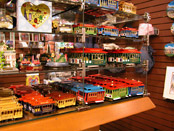
Miniature cable cars are a popular item
Fares & Riding Tips
- Back to Top
- Fares:
- Advance passes allowing you to ride the cable cars on an unlimited bases for a specified number of days are available from the ticket booths at Powell & Market Street or Hyde & Beach Street.
- 1-day ($13) 3-day ($20) or 7-day ($26) Muni Passports allow unlimited rides on all Muni vehicles including cable cars during a consecutive period which you can select. Monthly Passes ($70 Muni + BART or $60 Muni only) also cover unlimited cable car rides. These can be purchased from the ticket booths, but not on the cable cars.
- If you board a cable car without a pass, you have two choices:
- 1) Pay the conductor $5 per person (same price for adults and children 5 and up - younger than 5 ride free). This fare allows a single ride on one cable car (no matter how short the ride is) - it does not cover re-boarding, return trips, or transferring to another line.
- Or 2) You can purchase a $13 All-Day Passport on the cable car, which will allow unlimited rides only on the day of purchase. Cash only on the cable car, and operators will not make change for bills larger than $20.
- If you plan to exit along a cable car route, re-board, make a return trip, or ride multiple routes, the passes will work out to be less expensive than the regular fare. Visitors are often surprised by the fare prices, and the fact that single fares do not cover return trips or re-boarding.
- Riding Tips:
- Crowds and long lines are present at the turnaround points throughout most of the day. Powell & Market Street has the longest lines, partly because it serves the two most popular lines from a single location.
- The lines to board the California Street line are always shorter, but the ride is arguably less spectacular than on the Powell-Hyde and Powell-Mason routes.
- The lines are much shorter in the early morning (7am to 9am) and during the winter/early spring (January - March). The lines are longest in the afternoon.
- You can board a cable car at any point along its route where the "Cable Car Stop" sign is posted, IF (and this is a big if) the car is not already at full capacity. Operators will usually fill the cars completely at the starting points, making boarding at subsequent stops very difficult.
- To board at a route stop, you must wait on the right side of the street in the direction the car will be traveling. If you're at the correct intersection, but the wrong corner (see the "Do Not Board In This Area" sign), the operator will not stop for you.
- The stop at Powell & Post Street, at Union Square, is known locally as "Fantasy Island", due to the unlikelihood of being able to board a cable car at that point and the persistence of visitors in believing otherwise.
- If you board from a crowded location and take a seat on one of the outside benches, other riders will probably take the standing positions on the outside step in front of you, and you won't see much. Better to take one of the standing positions and let subsequent riders take the seats.
- The outside steps accommodate two riders at most in between each rail. If you try to squeeze in as a third, the conductor will ask you to move to another location, probably inside the cabin.
- You'll really need to hang on if you're standing, and this can make operating a camera difficult.
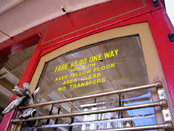
Cable car window showing price of fare: $5.00 one-way
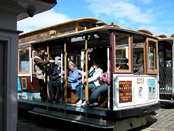
Conductors will check passes or collect money for fares after you've boarded the cable car
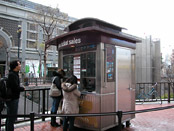
The ticket booth at Powell and Market sells advance or multiple-day passes
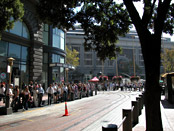
The line to board the cable cars at Powell and Market Street can get extremely long
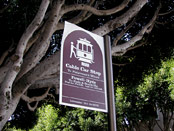
Cable cars will stop for you only if you're waiting at the correct corner, where these signs are posted
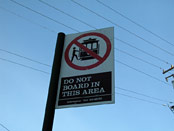
If you intend to board an approaching cable car, just make sure you're not standing by this sign
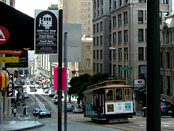
If a car is full, you won't be able to board, even if you're at a designated stop
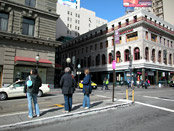
The cable car stop at Powell and Post Street at Union Square, also known as Fantasy Island
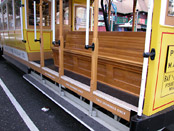
The running board can accommodate two standing riders between each rail, and conductors will enforce this
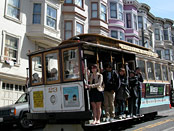
Standing on the outer step area can feel like you're floating above the street
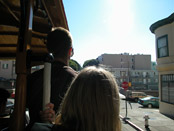
Standing offers the best views, but it is difficult to take photos while hanging on
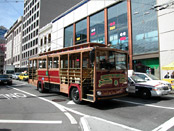
Not a cable car - motorized tour buses are often rigged up to look like cable cars
Cable Car History
- Back to Top
- The first experimental passenger cable car made its debut run in 1873 on Clay Street. Cable car developer Andrew Hallidie operated the car himself.
- In the late 1800s, cable cars are run on routes throughout the city by eight different independent companies.
- Cable cars were a dominant mode of transportation throughout the city, and destinations included Haight Street, Golden Gate Park, Valencia Street, and Ocean Beach and the Cliff House.
- Following the 1906 earthquake through the 1940s, electric vehicles and buses replace cable cars on flat routes beginning with Market Street. Cable cars remained on the steepest routes, as buses still had difficulty climbing the hills.
- In 1946-47, San Francisco Mayor Roger Lapham tried to shut down the remaining cable car lines. Public outcry (spurred by the activism of Friedel Klussman, to which the Hyde-Beach turnaround is dedicated) resulted in a recall of the mayor and the protection of the Cable Cars in the city charter. The three surviving lines can no longer be altered without a public vote.
- From September 1982 through June 1984, the entire system was shut down for renovations. Tracks and cable tunnels were rebuilt, cars were reconstructed, and the Cable Car Barn and Museum was rebuilt.
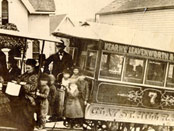
The first cable car line began operating in 1873 and ran up and down Clay Street
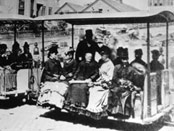
An unusual three-car train at Sutter and Larkin circa 1880
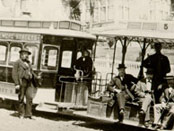
California Street Cable Railroad Cars in a photo reportedly including Adolph Sutro and Mark Twain, 1882
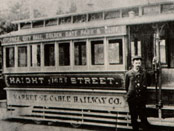
Market Street Cable Railway Car on Haight Street, 1890
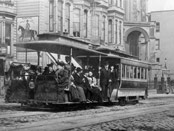
The Sutter Street Line, 1905
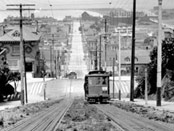
Cable car climbing Fillmore Street, circa 1905
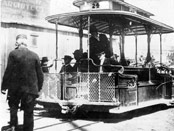
The only car belonging to the California Street Cable Railroad to survive the 1906 earthquake and fire
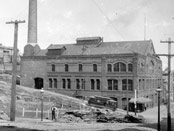
Cable Car Barn on Washington and Mason, 1906
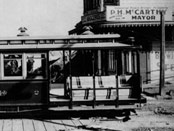
A two-grip reversible cable car, like those on California Street today, circa 1909
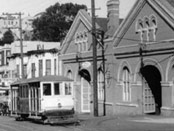
One of several original Cable Car Barns - this one on Castro, 1940
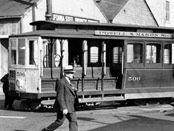
Cable car turnaround on Bay Street, 1940
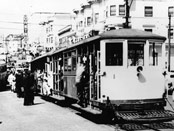
Long cable car running on Castro Street, 1941
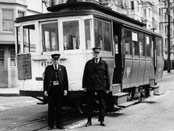
Uniformed cable car operators in front of a car on Fillmore Street, 1941
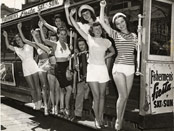
Riders promoting the Fishermen's Fiesta, 1946
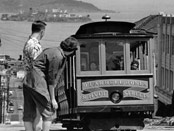
Cable car climbing Hyde Street, 1953
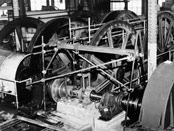
Wheels inside the Cable Car Barn, 1957
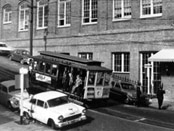
Cable Car Barn at Washington and Mason, 1967
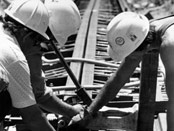
Laying cable car track in 1983 during replacement of tracks and cable tunnels
- Cable car info on other sites
- Info & history on sfcablecar.com
- The Cable Cars on streetcar.org
- The Cable Car Museum site
- Very in-depth informational resource from cable car insider Joe Thompson
Comments
Comment about San Francisco's Cable Cars here:









